The NVIDIA GeForce GTX Titan X Review
by Ryan Smith on March 17, 2015 3:00 PM ESTCompute
Shifting gears, we have our look at compute performance.
As we outlined earlier, GTX Titan X is not the same kind of compute powerhouse that the original GTX Titan was. Make no mistake, at single precision (FP32) compute tasks it is still a very potent card, which for consumer level workloads is generally all that will matter. But for pro-level double precision (FP64) workloads the new Titan lacks the high FP64 performance of the old one.
Starting us off for our look at compute is LuxMark3.0, the latest version of the official benchmark of LuxRender 2.0. LuxRender’s GPU-accelerated rendering mode is an OpenCL based ray tracer that forms a part of the larger LuxRender suite. Ray tracing has become a stronghold for GPUs in recent years as ray tracing maps well to GPU pipelines, allowing artists to render scenes much more quickly than with CPUs alone.
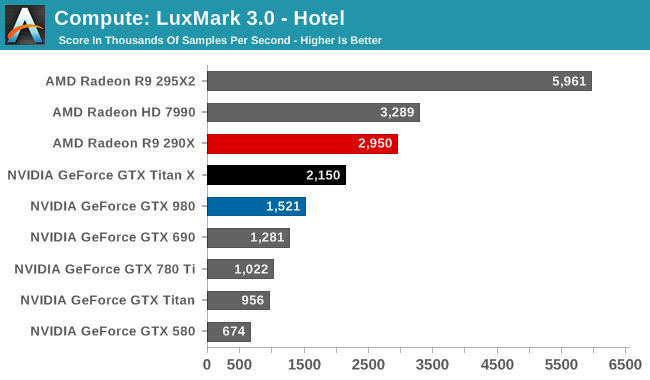
While in LuxMark 2.0 AMD and NVIDIA were fairly close post-Maxwell, the recently released LuxMark 3.0 finds NVIDIA trailing AMD once more. While GTX Titan X sees a better than average 41% performance increase over the GTX 980 (owing to its ability to stay at its max boost clock on this benchmark) it’s not enough to dethrone the Radeon R9 290X. Even though GTX Titan X packs a lot of performance on paper, and can more than deliver it in graphics workloads, as we can see compute workloads are still highly variable.
For our second set of compute benchmarks we have CompuBench 1.5, the successor to CLBenchmark. CompuBench offers a wide array of different practical compute workloads, and we’ve decided to focus on face detection, optical flow modeling, and particle simulations.
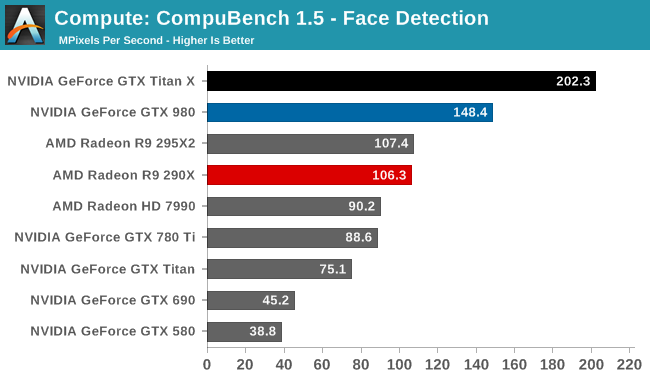
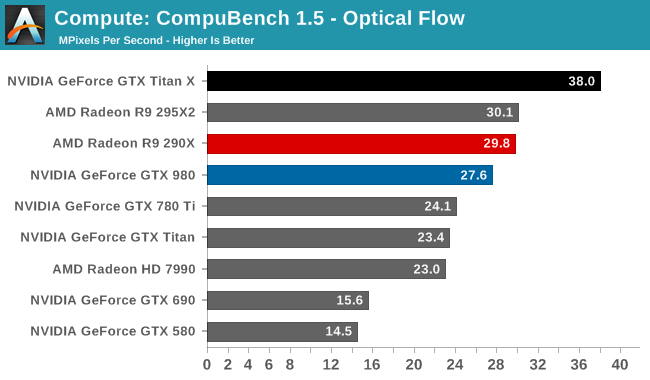
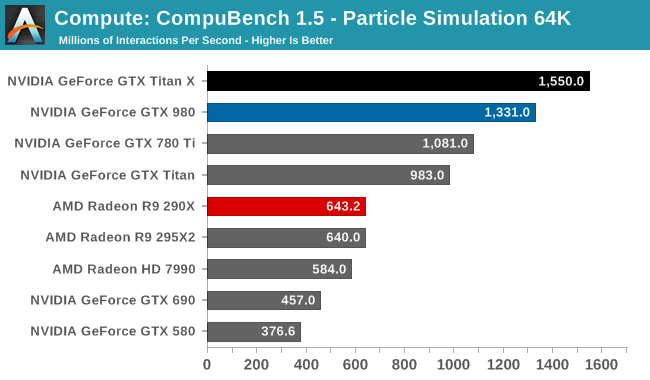
Although GTX Titan X struggled at LuxMark, the same cannot be said for CompuBench. Though the lead varies with the specific sub-benchmark, in every case the latest Titan comes out on top. Face detection in particular shows some massive gains, with GTX Titan X more than doubling the GK110 based GTX 780 Ti's performance.
Our 3rd compute benchmark is Sony Vegas Pro 13, an OpenGL and OpenCL video editing and authoring package. Vegas can use GPUs in a few different ways, the primary uses being to accelerate the video effects and compositing process itself, and in the video encoding step. With video encoding being increasingly offloaded to dedicated DSPs these days we’re focusing on the editing and compositing process, rendering to a low CPU overhead format (XDCAM EX). This specific test comes from Sony, and measures how long it takes to render a video.

Traditionally a benchmark that favors AMD, GTX Titan X closes the gap some. But it's still not enough to surpass the R9 290X.
Moving on, our 4th compute benchmark is FAHBench, the official Folding @ Home benchmark. Folding @ Home is the popular Stanford-backed research and distributed computing initiative that has work distributed to millions of volunteer computers over the internet, each of which is responsible for a tiny slice of a protein folding simulation. FAHBench can test both single precision and double precision floating point performance, with single precision being the most useful metric for most consumer cards due to their low double precision performance. Each precision has two modes, explicit and implicit, the difference being whether water atoms are included in the simulation, which adds quite a bit of work and overhead. This is another OpenCL test, utilizing the OpenCL path for FAHCore 17.
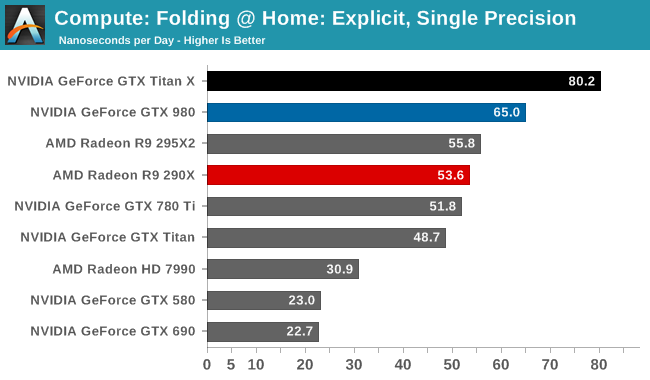
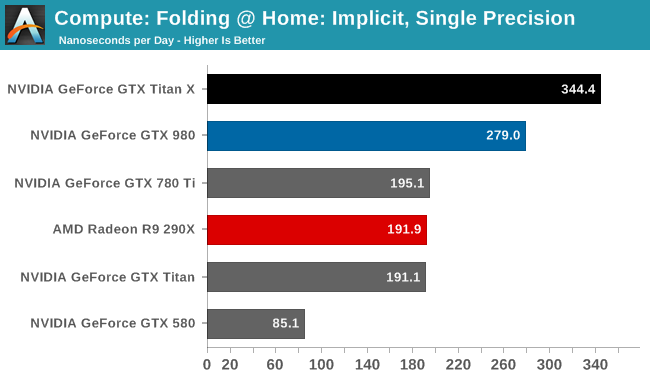
Folding @ Home’s single precision tests reiterate just how powerful GTX Titan X can be at FP32 workloads, even if it’s ostensibly a graphics GPU. With a 50-75% lead over the GTX 780 Ti, the GTX Titan X showcases some of the remarkable efficiency improvements that the Maxwell GPU architecture can offer in compute scenarios, and in the process shoots well past the AMD Radeon cards.
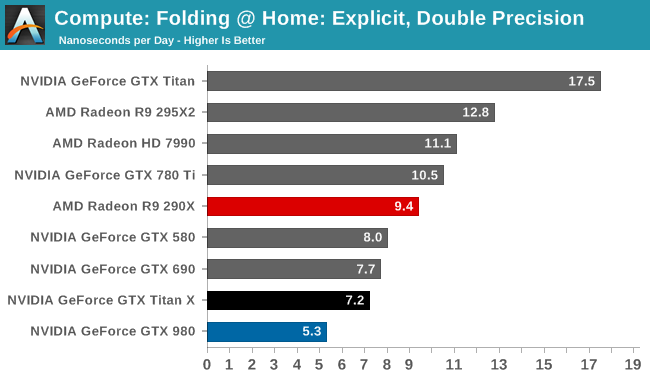
On the other hand with a native FP64 rate of 1/32, the GTX Titan X flounders at double precision. There is no better example of just how much the GTX Titan X and the original GTX Titan differ in their FP64 capabilities than this graph; the GTX Titan X can’t beat the GTX 580, never mind the chart-topping original GTX Titan. FP64 users looking for an entry level FP64 card would be well advised to stick with the GTX Titan Black for now. The new Titan is not the prosumer compute card that was the old Titan.
Wrapping things up, our final compute benchmark is an in-house project developed by our very own Dr. Ian Cutress. SystemCompute is our first C++ AMP benchmark, utilizing Microsoft’s simple C++ extensions to allow the easy use of GPU computing in C++ programs. SystemCompute in turn is a collection of benchmarks for several different fundamental compute algorithms, with the final score represented in points. DirectCompute is the compute backend for C++ AMP on Windows, so this forms our other DirectCompute test.
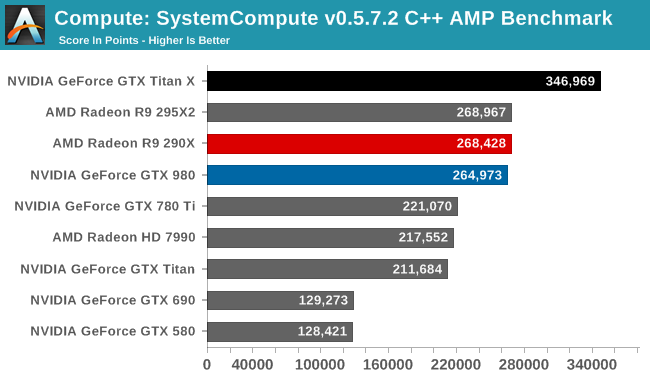
With the GTX 980 already performing well here, the GTX Titan X takes it home, improving on the GTX 980 by 31%. Whereas GTX 980 could only hold even with the Radeon R9 290X, the GTX Titan X takes a clear lead.
Overall then the new GTX Titan X can still be a force to be reckoned with in compute scenarios, but only when the workloads are FP32. Users accustomed to the original GTX Titan’s FP64 performance on the other hand will find that this is a very different card, one that doesn’t live up to the same standards.










276 Comments
View All Comments
joeh4384 - Tuesday, March 17, 2015 - link
Old news.joeh4384 - Tuesday, March 17, 2015 - link
I bet if you overclock the crap out of this, its TDP shoots north of 300 watts.cmdrdredd - Tuesday, March 17, 2015 - link
People buying this don't care about TDP.Kutark - Tuesday, March 17, 2015 - link
Which means even with OC it would still be at or under a 290x. I'm failing to see the problem here.TDP is really only super important for compute cards that will be running for hours on end at 100% load.
FlushedBubblyJock - Thursday, April 2, 2015 - link
I didn't care either, my $800 FX9590 loved 320 watts and my "uber" two niner zeroX loved double dipping that 320 watts, so I converted my carbon arc Linclon 220 welder to handle the AMD juice load and my DVD/RW/DL/LS melted tight to my CM heavy tower and dripped bubbling fire plastic drops through my liquid AMD loop... bye bye overclockshing3232 - Tuesday, March 17, 2015 - link
It does not make anything, because 290x is a old CardStuka87 - Tuesday, March 17, 2015 - link
You can't take those numbers seriously though, as they are wrong. Anandtech is *STILL* using reference cards for these tests. You have not been able to buy reference cards for over a year now. The current cards are run MUCH cooler, MUCH quieter, use less power, and have better performance.Stuka87 - Tuesday, March 17, 2015 - link
Quick edit, it seems XFX is still selling a reference 290X. No clue why, but they are. You can get custom cooled AIB cards for less. Could just be leftover stock though I suppose.Ryan Smith - Tuesday, March 17, 2015 - link
Using reference cards is consistent with our long-standing policy to use them. Aside from the immediate definition of reference, I believe that it is very important not to cherry pick results. The results you in our reviews should be equal to or lower than the results you will get with a retail card - we specifically want to avoid publishing results higher than what the buyer can get.* We don't want to overstate the performance of a card.* Using the same testbed hardware as us of course.
beginner99 - Tuesday, March 17, 2015 - link
Still it shows the 290(x) in a way poorer light than is actually true. At least that should be stated but better would be to add a AIB card to the reviews,